
High-Dimensional Thinking using the body
・The body is stationary in school
At school, students must take tests alone while sitting quietly. As symbolized by this example, knowledge so far has entailed using the brain whilst keeping the body stationary, and limiting the amount of information. For example, the amount of information in a problem such as “1+1=” is several bytes. What we call “knowledge” that is taught in school, discards the body: it is acquired through language and mathematics, which in terms of information volume is extremely small. However, if we take a quick look around ourselves, it is clear that the world comprises an immense amount of information.
・The ability to engage with people and the world
There are a variety of skills, such as sociability, leadership, and communication, that are all connected to the ability to engage with people and the world. These abilities require extreme cerebral activity to process the enormous amount of spatial information that is constantly changing, such as the expressions and behavior of people in our surroundings. This is a set of intellectual activities that vastly differs from the intelligence used when the body is fixed in place, processing small amounts of information, as is the case with studying in school.
・Humans perceive the world with their bodies and think with their bodies
Creating and telling stories that move people emotionally is not a skill that can be achieved only through repetitive training in writing compositions. Stories are spun from the experiences that are cultivated while exploring the world with our bodies.
Humans perceive the world with their bodies and think with their bodies.
・The body is a massive information network
In reality, in addition to the brain instructing the body, it has become clear that the body is a massive information network in which various organs and cells are performing dynamic exchanges of information. For example, we are beginning to understand that the muscles and bones that move the body are contributing to the development of the hippocampus (the part of the brain related to memory and spatial awareness) and instructing the hippocampus to form memories.
・Spatial awareness
In recent years, it is said that spatial awareness, which is the ability to understand spatial relations between objects and store them in memory, is just as important as linguistic and mathematical abilities. Spatial awareness is thought to play an important role in creativity and innovation.
Furthermore, we are beginning to understand that the hippocampus, which is related to spatial awareness, develops through the body exploring and walking around varied and complex spaces. In an experiment with mice, the hippocampi of mice that explored varied and complex spaces had 40,000 times as many nerve cells than those of mice that did not explore such spaces, and that the volume of the hippocampi increased by 15%, resulting in greater spatial awareness. However, children in the modern age are not able to play freely outside. According to one study, the duration of time that children in the United States played freely outside decreased by 25% between 1981 and 1997.*
*Science Magazine Nautilus For Kids, Learning Is Moving
・Three-dimensional and Higher-Dimensional Thinking
Spatial awareness is not only about the space itself, but is connected to the ability to understand and think about the world in three dimensions. teamLab calls this 'three-dimensional thinking', and thinking on an even higher dimension, Higher-Dimensional Thinking.
・Extracting an egg yolk from an egg without breaking the shell
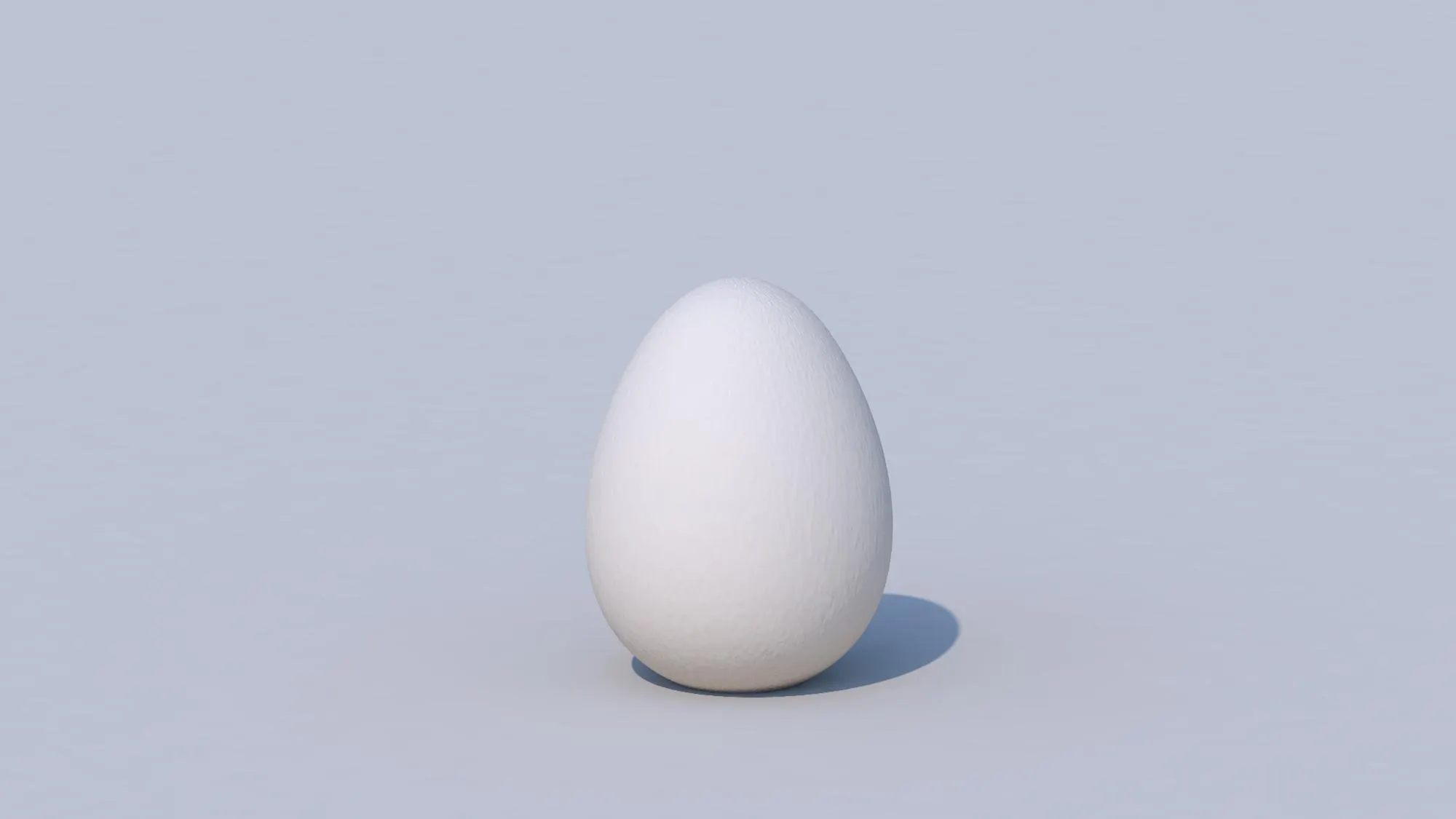
Is it possible to extract an egg yolk without breaking the eggshell?
We tend to believe that we cannot extract the yolk without cracking the egg. That is because we are thinking in three dimensions. However, if we think in four dimensions, it may be possible that the yolk can be extracted without cracking the egg. It is hard for us to imagine this, as we live in three-dimensional space.
As this is difficult, let us think of the egg as a flat fried egg - a two-dimensional object. In the three-dimensional world that we inhabit, we can extract the yolk of the fried egg from above, so we can easily extract the yolk without breaking the egg white. However, in a flat, two-dimensional world, we would exist on the same flat plane as the white egg. Therefore, as we would need to pass the same plane as the fried egg to extract the yolk, we would need to break the egg white to extract the yolk.
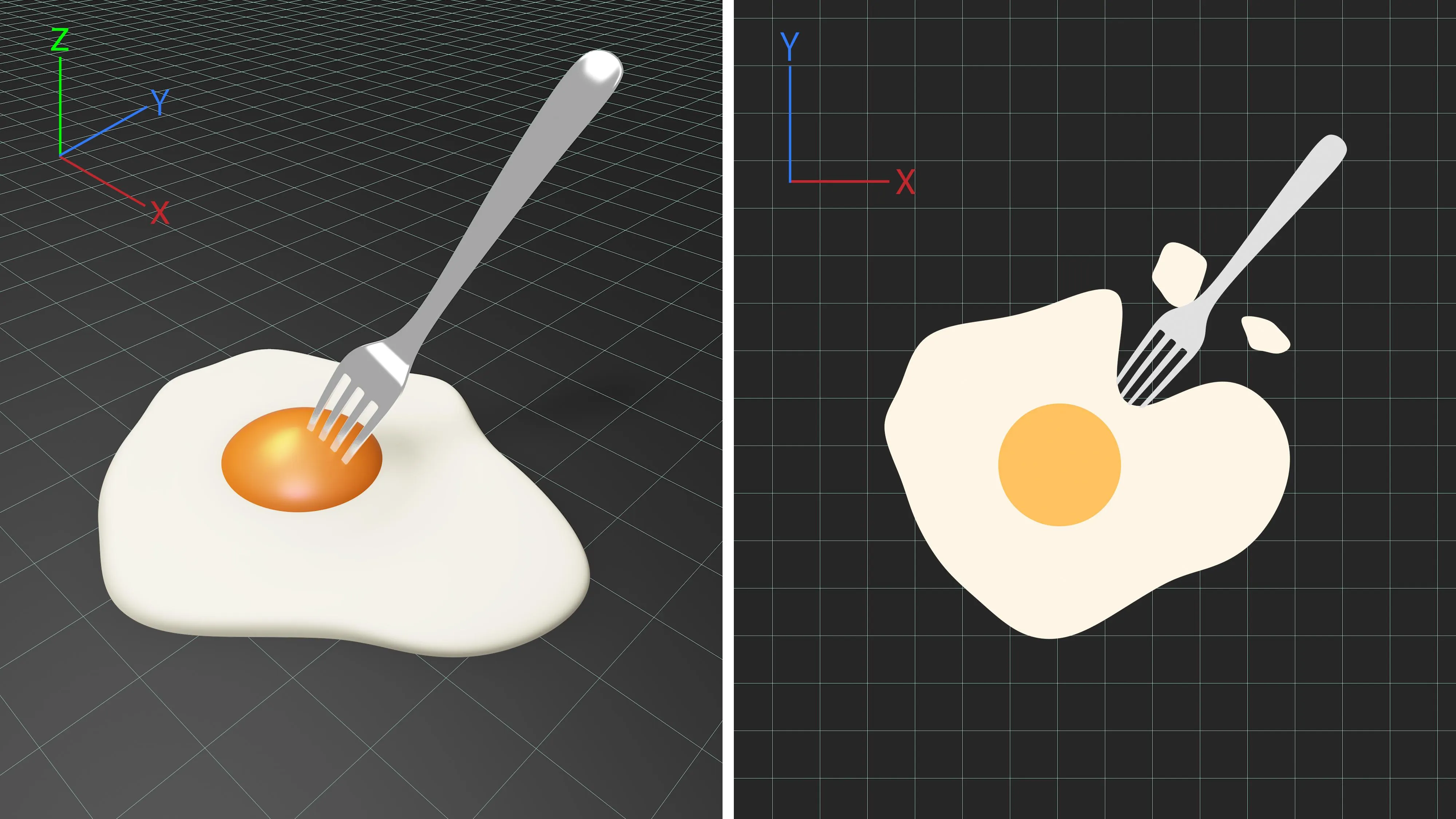
As demonstrated, thinking two-dimensionally and thinking three-dimensionally are literally on different dimensions. Being in different dimensions means that how things are seen and thought of, along with methods of problem-solving, are completely different.
If we consider the fourth dimension to be time, there may be a way to extract the yolk without cracking the shell, even in our real world.
・Cities are made of flat planes; TVs, and smartphones are also flat planes
In nature, such as forests and mountains, there are no flat planes, and the landscape is complex and three-dimensional. Humans used to perceive three-dimensional spaces with their bodies. However, in the city, there are only flat planes. Furthermore, paper, books, TVs, and smartphones are also flat planes. Without realizing it, we abandon our bodies and perceive the world two-dimensionally, solely with our minds. If we perceive the world two-dimensionally, our thoughts become two-dimensional. For example, if the company that you work for has a diagram called an organizational chart, your organization is two-dimensional, and therefore naturally, two-dimensional thinking is prevalent in your organization.
・High-Dimensional Thinking using the body
Humans understand the world and think with their bodies. By exploring a complex, three-dimensional world with their bodies, humans understand the world three-dimensionally, and their thoughts become three-dimensional. The Athletics Forest project, a physically challenging four-dimensional world where time changes with the presence of your body, began with the hope of encouraging the enhancement of three-dimensional and higher-dimensional thinking through the human body.
FEATURED WORKS
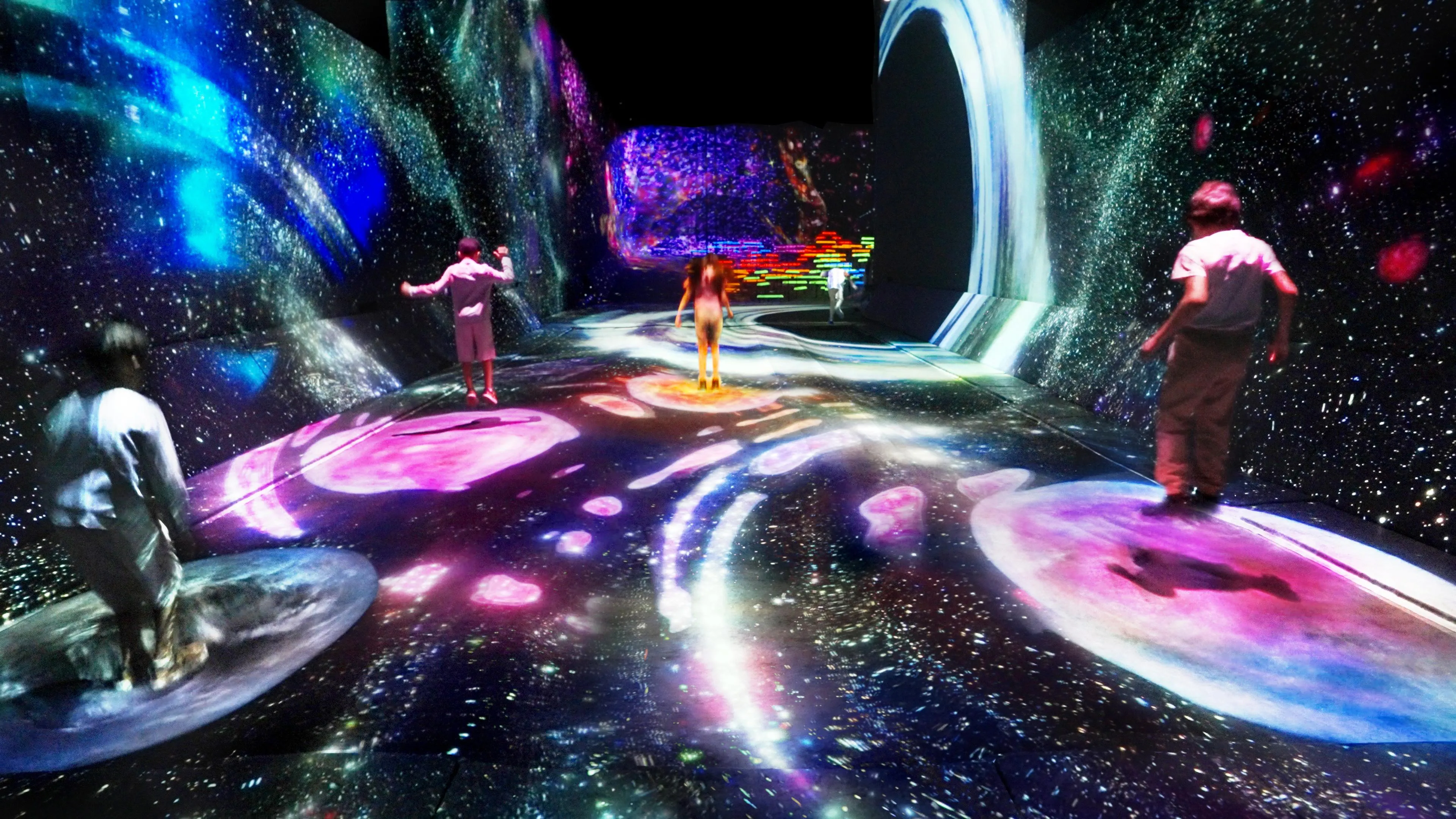
teamLab, 2022-, Interactive Installation, Sound: DAISHI DANCE
Multi Jumping is a flexible surface that people can jump on, and sink or jump higher than usual.
When you stand on Multi Jumping, the surface beneath your feet sinks, creating warps in space and time. This distortion attracts stardust from the universe and births new stars. If you jump on top of a star, it begins to move, and if you continue to jump on the star it will grow and you will be able to experience the entire life cycle of the star. When the life of the star ends, it returns to stardust and becomes the building blocks of new stars.
A gigantic and heavy star will eventually become a black hole that swallows up all the surrounding stars and stardust.

Aerial Climbing through a Flock of Colored Birds
teamLab, 2018-, Interactive Installation, Sound: teamLab
Aerial Climbing is a space where horizontal bars of varying colors are suspended by ropes and float three-dimensionally in the air. People use these bars to navigate the space in mid-air through three dimensions, trying not to fall. As the bars are linked, the movement caused on a bar by a person will affect the bars on which other people are standing. The arrangement of the bars vary depending on the selected route, so people’s experiences will differ depending on the various ways the bars are linked.
When people climb onto the bars, they shine brightly and produce a sound specific to its color. The more people climb onto bars of different colors, the more sounds will be played at the same time.
Flocks of birds fly around freely in this space. When they fly near the people in the space, they take on the color of the bars on which the people stand.
The movement of thousands of birds is beautiful and mysterious, appearing like a single giant life form. The flock has neither a leader nor mutual consensus, but it is said that the birds move on the simple basis of; if my neighbor moves, then I move too. However, the biological mechanism that causes hundreds of birds to move at the same time remains a mystery. It seems there is a universal principle that humans have yet to understand. Likewise, the arrangement of color of the flock is not predetermined. Influenced by people, the birds move, based on a primitive rule unknown to humankind, which in turn creates a complex and beautiful coloration in the space.
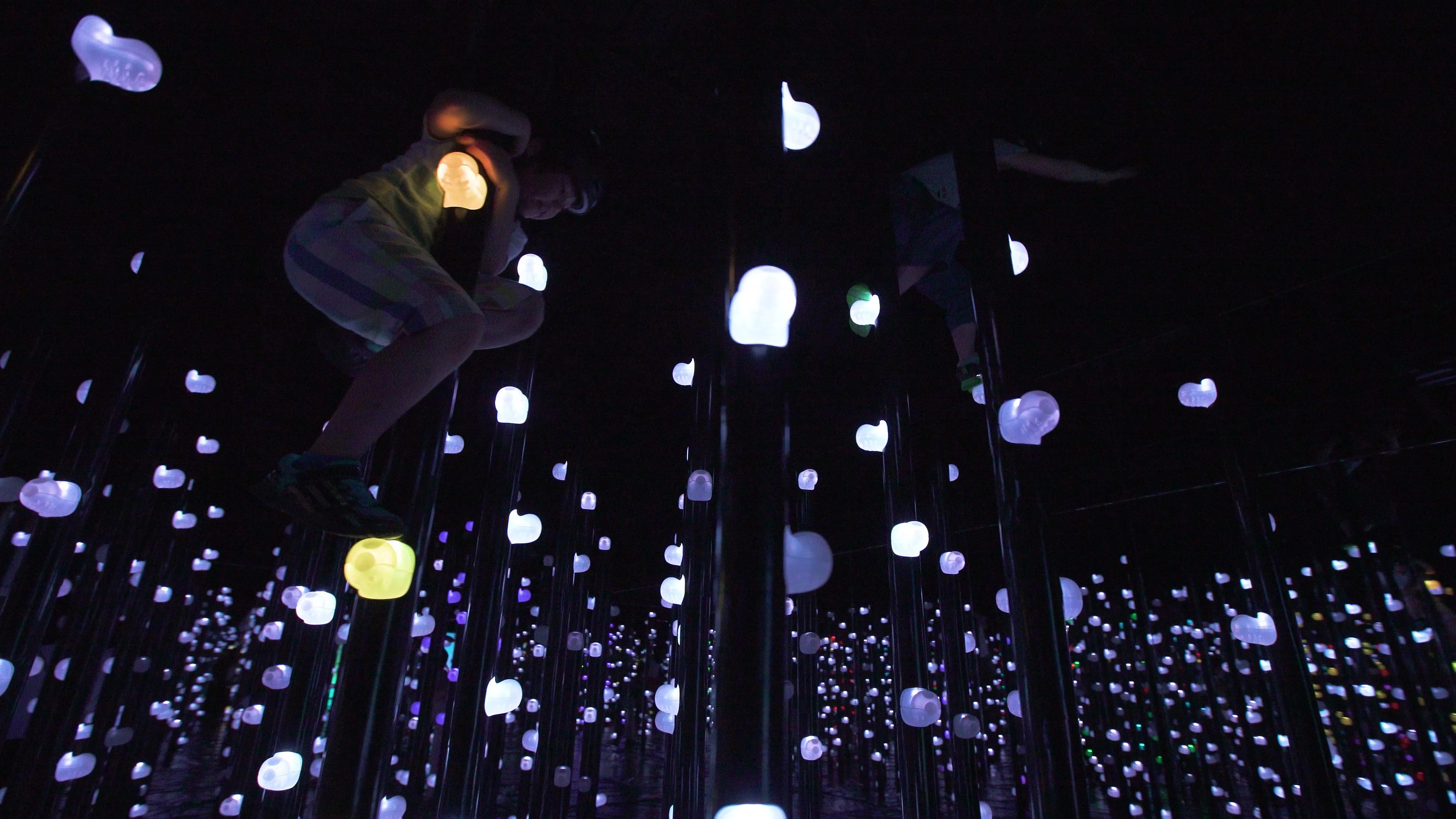
Light Three-dimensional Bouldering
teamLab, 2018-, Interactive Digital Installation, Sound: DAISHI DANCE
Vedi Altro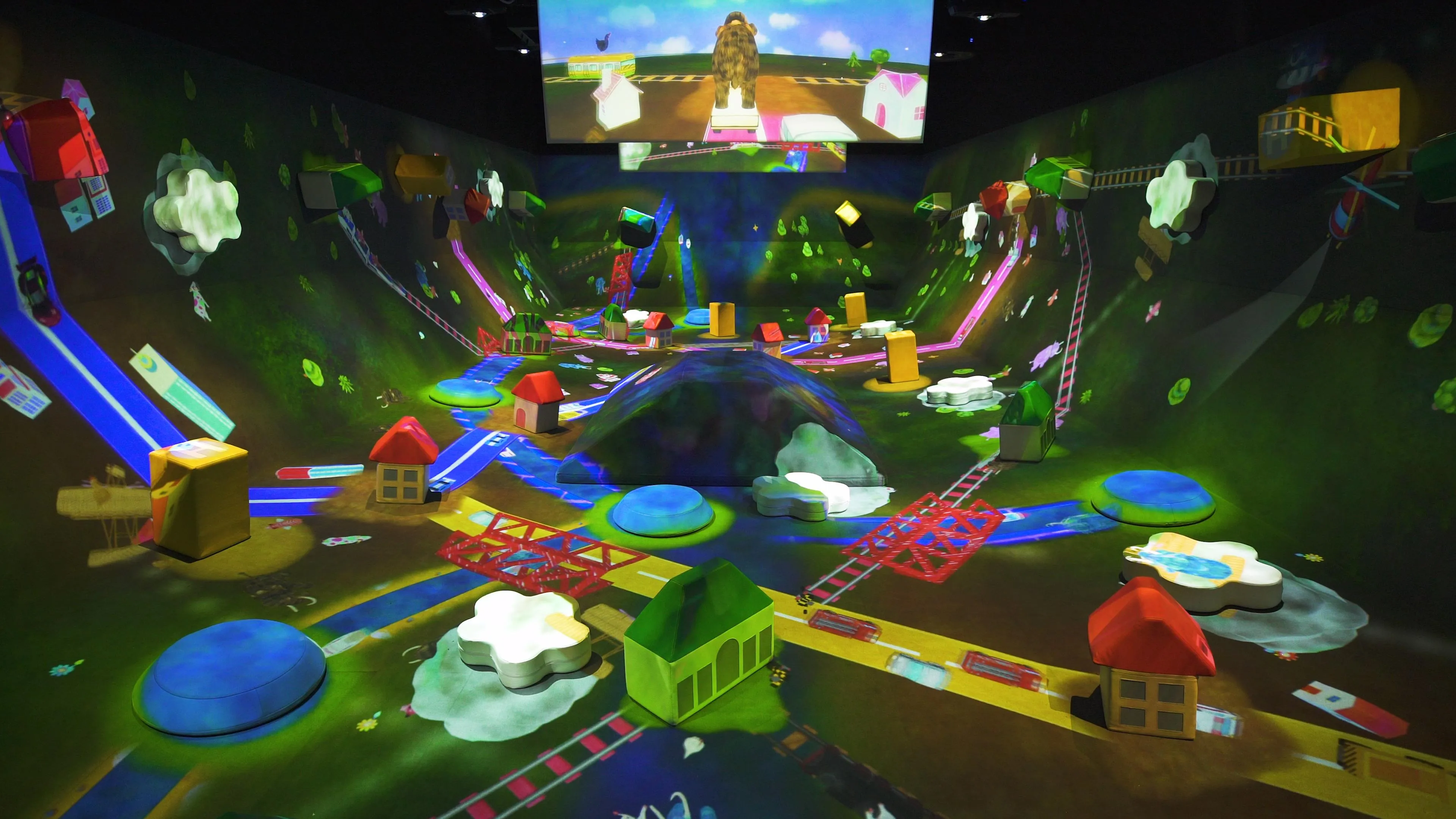
Inverted Globe, Giant Connecting Block Town
teamLab, 2018-, Interactive Digital Installation, Sound: Hideaki Takahashi
Make the city come to life by placing giant building blocks of houses and stations, running various vehicles such as cars and trains, and developing transport systems.
When blocks of the same kind are placed nearby, they are connected to let the vehicles move along the routes created. Connect the blocks, and the vehicles will evolve more and more. Helicopters fly from the building and the world seen from the helicopter is projected on the screen in the sky.
The world has a river running through it. When it rains, the river floods and the water runs into the city. However, building a waterway with pond blocks and connecting the waterway to the sea will prevent flooding.
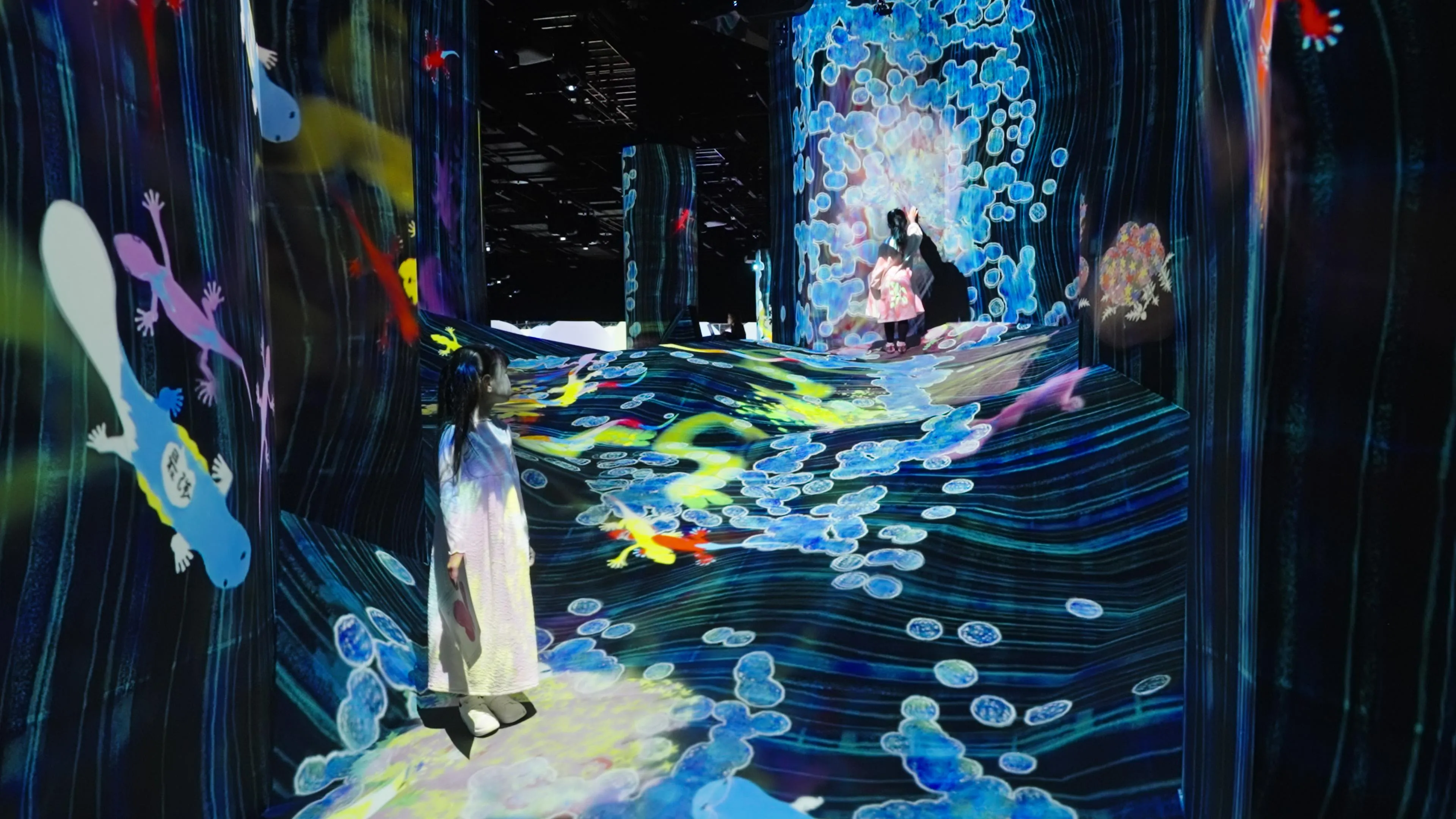
Waterfall Droplets, Little Drops Cause Large Movement
teamLab, 2018-, Interactive Installation, Sound: Hideaki Takahashi
When just one droplet splashes it bounces like a ball, but when people use their entire body to gather and collect the droplets, they act like water.
When the droplets separate from each other, they bounce like balls again.
A water molecule on its own is not liquid. In order for water to be a liquid, many water molecules must come together.
Because water molecules act like magnets, they stick to each other, forming a group of water molecules (a water cluster). Water clusters have an extremely short lifespan and are thought to be constantly being created and broken apart. They have a very dynamic structure and because of that, water can change into various forms.
Most living things and objects in this world, through properties that are more than the simple sum of the properties of their parts, appear as a whole.